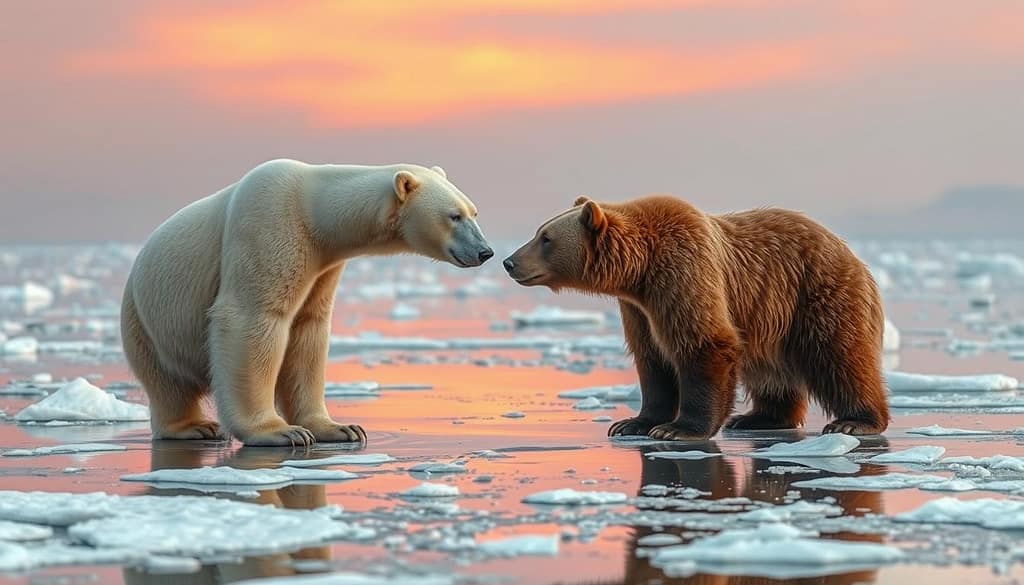Polar Bear vs Grizzly: A Battle for Survival in a Changing Climate
In North America’s vast wilderness, two powerful predators face a new challenge. Once in different places, grizzly and polar bears meet more often now. Climate change is changing their homes, bringing them closer together. In this article, we will discuss the ultimate battle for the survival of polar bear vs grizzly bear: who will win this battle against climate change?

The Arctic’s ice is melting, pushing polar bears south. At the same time, warmer weather lets grizzlies go north. This means they now compete for food and space in a new way.
Key Takeaways
- Climate change is causing polar bear and grizzly habitats to overlap
- Polar bears are being forced south as Arctic ice melts
- Grizzly bears are expanding their range northward due to warming temperatures
- Both species face new challenges in adapting to changing environments
- Competition between polar bears and grizzlies for resources is increasing
- The survival of both species is at stake in this climate-driven conflict
The Titans of the North: Introducing Polar Bears and Grizzlies
In North America’s vast wilderness, polar bears and grizzly bears rule. These iconic animals amaze us with their strength and grace. Let’s dive into what makes them special and how they compare physically.
Polar Bears: Masters of the Arctic
Polar bears are the biggest land carnivores, living in the Arctic’s cold. Their white fur blends in with snow, and their huge paws help them move on ice. They are also great swimmers, hunting seals in icy waters.
Grizzly Bears: Rulers of the Wilderness
Grizzly bears, a type of brown bear, rule forests and mountains. Their muscle hump on the shoulders lets them dig deep. They eat everything from berries to fish, showing they can thrive in many places.
Comparing Size, Weight, and Physical Features
Both species are powerful, but they look and size differently. Here’s a look at their physical differences:
| Feature | Polar Bear | Grizzly Bear |
|---|---|---|
| Average Weight | 900-1,600 lbs | 400-790 lbs |
| Body Length | 7.25-8 feet | 6.5-7 feet |
| Fur Color | White | Brown with silver tips |
| Unique Feature | Elongated neck | Shoulder hump |
This comparison shows that polar bears are heavier than grizzlies. Polar bears live in the harsh Arctic, where they need to be bigger to survive.
Habitat and Adaptation: Ice vs Land
Polar bears and grizzlies live in very different places, and each place shapes their behaviour, diet, and survival.
Polar Bears’ Icy Domain
Polar bears rule the Arctic, where sea ice is their home. They mostly live on the ice, hunting seals and other prey. Their white fur blends in with the snow and ice. Their big, paddle-like paws help them move on ice and swim well.

Grizzlies’ Terrestrial Territory
Grizzly bears live in many places, from dense forests to open tundra. They are good at living in different climates and terrains in North America. Their strong claws are great for digging, fishing, and climbing. They also have a strong sense of smell when looking for food.
Climate Change: Blurring the Lines
As the world gets warmer, the homes of polar and grizzly bears are changing. Polar bears have to spend more time on land because of melting sea ice. Grizzlies can move north because of warmer weather. This makes it hard for both species to find food and adapt to their new homes.
| Characteristic | Polar Bears | Grizzly Bears |
|---|---|---|
| Primary Habitat | Sea ice, Arctic coasts | Forests, mountains, tundra |
| Adaptation to Climate | Thick blubber layer, water-repellent fur | Seasonal fat reserves, hibernation |
| Impact of Climate Change | Loss of sea ice habitat | Expanding northern range |
Polar Bear vs Grizzly: A Hypothetical Showdown
Imagine a showdown between the polar bear and the grizzly, two of nature’s strongest predators. This battle sparks curiosity about who would come out on top. Such fights are rare but possible as climate change brings these animals closer together.

An adult male polar bear is bigger than a male grizzly, giving it a power advantage. Polar bears have longer claws and teeth, perfect for hunting seals on ice. Grizzlies, though smaller, are incredibly strong and agile, thanks to their rugged habitats.
Fighting polar bears use their size to overpower opponents. They are great in water, where their swimming skills give them an edge. Grizzlies, on the other hand, are versatile fighters, skilled in both offence and defence on land.
| Attribute | Polar Bear | Grizzly Bear |
|---|---|---|
| Average Weight | 900-1,600 lbs | 400-790 lbs |
| Claw Length | 2-3 inches | 2-4 inches |
| Bite Force | 1,200 PSI | 1,160 PSI |
| Habitat Advantage | Ice and Water | Land and Forest |
The winner of a polar bear vs grizzly fight depends on the setting. In water or on ice, the polar bear’s skills are unmatched. But on land, the grizzly’s agility and climbing abilities could give it an edge.
Both species are incredibly powerful predators, each with its own strengths. Their hypothetical fight highlights the need to protect their habitats. This way, they can continue to thrive as the top predators in their worlds.
Dietary Differences: Seal Hunters vs Omnivorous Foragers
Polar bears and grizzlies have different eating habits, which are shaped by their environments. Let’s examine how these amazing animals find food in their homes.
Polar Bears: Specialized Marine Mammal Predators
Polar bears are experts at hunting marine mammals. Their main food is seals. They are great swimmers, chasing seals in icy waters.
When a seal comes up to breathe, the polar bear attacks fast and strong.
Grizzlies: Versatile Omnivores
Grizzly bears eat both plants and animals. Their diet changes based on what’s available. They enjoy berries, roots, and grasses.
They also hunt small mammals like ground squirrels. Sometimes, they go after bigger prey like caribou.
Adapting to Changing Food Sources
Climate change is making it harder for both species to find food. Polar bears now eat beached whales because they can’t find seals. Grizzlies are moving north, which means more competition for food.
This change might make them change how they hunt and eat. They need to adapt to survive in a world that’s changing fast.
| Bear Species | Primary Diet | Hunting Method |
|---|---|---|
| Polar Bear | Seals, Marine Mammals | Stalking, Ambush |
| Grizzly Bear | Plants, Berries, Small Mammals | Foraging, Digging, Chasing |
Conservation Challenges: Two Species, One Warming Planet
Climate change is a big problem for polar bears and grizzlies. These top predators face big challenges in their changing homes. We’ll look at the big issues they face.
Shrinking Sea Ice: Polar Bears’ Existential Threat
Polar bears need sea ice to hunt and breed. But as the Arctic warms, the ice melts sooner and forms later. This means bears have to swim longer, which makes hunting harder and increases drowning risks.
Habitat Fragmentation: Grizzlies’ Struggle
Human activities are causing grizzly bears to lose their homes. Roads, buildings, and industries are splitting their lands, making it hard for them to find food, which can lead to smaller populations.
Human-Bear Conflicts: A Growing Concern
As bears lose their homes, they run into people more often. They look for food in human areas, causing dangerous situations. This can lead to bears being moved or killed, hurting their numbers even more.
| Conservation Challenge | Polar Bears | Grizzly Bears |
|---|---|---|
| Primary Threat | Shrinking sea ice | Habitat fragmentation |
| Impact on Feeding | Reduced access to seals | Limited food sources |
| Human Interaction | Increased conflicts near settlements | Encounters in expanding urban areas |
Efforts to save these bears include protecting their homes, reducing conflicts with people, and fighting climate change. These actions are key to keeping polar and grizzly bears alive in our changing world.
Conclusion
The polar bear vs grizzly comparison shows two amazing species facing big challenges. Climate change is changing their homes, and they must adapt to live. Polar bears rely on sea ice, which is melting fast. Grizzlies face problems like losing their homes and dealing with people.
It’s vital to save both bears. We need to protect their homes and reduce conflicts with humans. As the world warms, it’s key to know how these bears can live together. Their ability to adapt is crucial for their future.
The tale of polar bears and grizzlies teaches us about our planet’s balance. It shows we must fight climate change and protect nature. Saving these iconic bears helps keep our ecosystems healthy for future generations.
